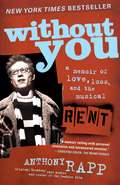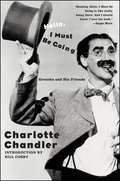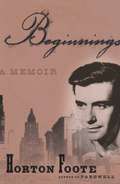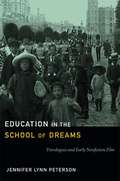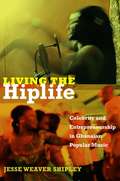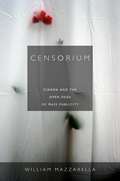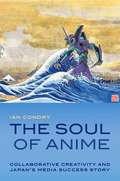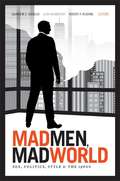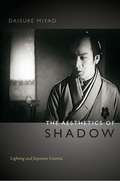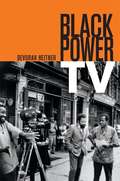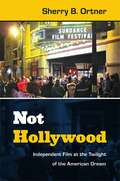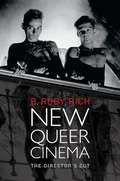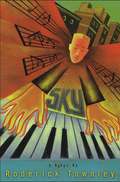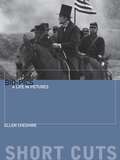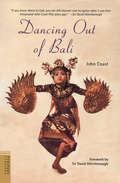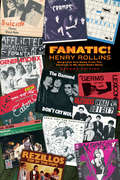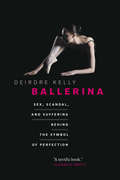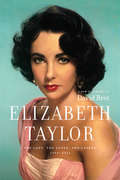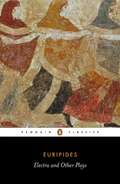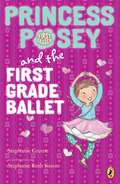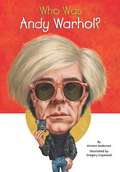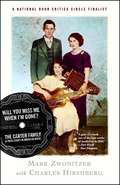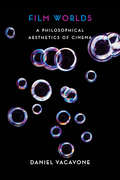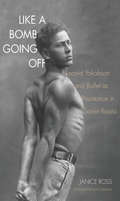- Table View
- List View
Without You
by Anthony RappAnthony Rapp captures the passion and grit unique to the theatre world as he recounts his life-changing experience in the original cast of the Pulitzer Prize-winning musical Rent. Anthony had a special feeling about Jonathan Larson's rock musical from his first audition, so he was thrilled when he landed a starring role as the filmmaker Mark Cohen. With his mom's cancer in remission and a reason to quit his newly acquired job at Starbucks, his life was looking up. When Rent opened to thunderous acclaim off Broadway, Rapp and his fellow cast members knew that something truly extraordinary had taken shape. But even as friends and family were celebrating the show's success, they were also mourning Jonathan Larson's sudden death from an aortic aneurysm. By the time Rent made its triumphant jump to Broadway, Larson had posthumously won the 1996 Pulitzer Prize. When Anthony's mom began to lose her battle with cancer, he struggled to balance the demands of life in the theatre with his responsibility to his family. Here, Anthony recounts the show's magnificent success and his overwhelming loss. He also shares his first experiences discovering his sexuality, the tension it created with his mother, and his struggle into adulthood to gain her acceptance. Variously marked by fledgling love and devastating loss, piercing frustration and powerful enlightenment, Without You charts the course of Rapp's exhilarating journey with the cast and crew of Rent as well as the intimacies of his personal life behind the curtain.
Hello, I Must Be Going
by Charlotte ChandlerWhen Charlotte Chandler called Groucho Marx for an interview, he answered the phone himself. Declining to be interviewed, he invited her over to his house so he could tell her no in person. After talking with her for hours, Groucho asked, "Why aren't you writing?" Hello, I Must Be Going is the story of Groucho and the Marx Brothers, told through Groucho's everyday conversations with Charlotte Chandler and his friends. And what a group of friends they were! Woody Allen, Jack Nicholson, Elliott Gould, Bill Cosby, Marvin Hamlisch, Betty Comden, Adolph Green, Sidney Sheldon, and dozens of others walk through the pages of this fascinating book. Anyone interested in Groucho or the Marx Brothers, or who wants to spend a few hours in fabulous company, will find this book irresistible.
A Deed of Death: The Story Behind the Unsolved Murder of Hollywood Director William Desmond Taylor
by Robert GirouxWell-born but disinherited Anglo-Irish actor and one-time Yukon prospector, William Desmond Taylor was a prominent Paramount movie director at the time of his unsolved murder in 1922. Suspects included his secretary Edward Sands, a thief and forger; Henry Peavey, his homosexual black cook; and two flamboyant screen stars: drug-addicted Mabel Normand, whom he loved; and 20-year-old Mary Miles Minter, who yearned to be his mistress. In a meticulous probe that reads like a detective thriller, editor-publisher Giroux ( The Book Known as Q ) makes a strong case that the murderer was a contract killer. He shows that Normand had incurred the wrath of dope peddlers, as did Taylor when he attempted to help her break her addiction. Brimming with details of Hollywood's silent era and its rampant post-WW I drug culture, this procedural offers glimpses of Mary Pickford, Charlie Chaplin, Sam Goldwyn, Mack Sennett, Fatty Arbuckle. Illustrations. Copyright 1990 Reed Business Information, Inc.
Beginnings
by Horton FooteSince 1939, Horton Foote, "the Chekhov of the small town," has chronicled with compassion and acuity the experience of American life both intimate and universal. His adaptation of Harper Lee's To Kill a Mockingbird and his original screenplay Tender Mercies earned him Academy Awards. He has won a Pulitzer Prize, the Gold Medal for Drama from the American Academy of Arts and Letters, the PEN/Laura Pels Foundation Award for Drama, and the President's National Medal of Arts. Beginnings is the story of Foote's discovery of his own vocation. He didn't always want to write. When he left Wharton, Texas, at the age of sixteen to study at the Pasadena Playhouse, Foote aspired to be an actor. He remembers the terror and excitement of leaving home during the Depression, his early exposure to the influences of German theater, and the speech lessons he took to "cure" him of his Southern drawl. He eventually arrives in New York to search for acting jobs and to study with some of the great Russian and American teachers of the 1930s. But after mixed results on the stage, he finally recognizes his true passion, writing. From Martha Graham to Tennessee Williams, from Agnes de Mille to Lillian Gish, Horton collaborates with great artists in both dance and theater. The world he describes of fierce commitment and passion regardless of financial rewards is both captivating and inspiring. Through it all Horton maintains his genuine Southern charm, and he often travels home to Wharton, the town that nurtured him as a storyteller and has inspired his writing for the past sixty years. From one of the most moving and distinctive voices of our time, Beginnings is a rare, personal look at a fascinating era in American life, and at the making of a writer.
Education in the School of Dreams: Travelogues and Early Nonfiction Film
by Peterson Jennifer LynnIn the earliest years of cinema, travelogues were a staple of variety film programs in commercial motion picture theaters. These short films, also known as "scenics," depicted tourist destinations and exotic landscapes otherwise inaccessible to most viewers. Scenics were so popular that they were briefly touted as the future of film. But despite their pervasiveness during the early twentieth century, travelogues have been overlooked by film historians and critics. In Education in the School of Dreams, Jennifer Lynn Peterson recovers this lost archive. Through innovative readings of travelogues and other nonfiction films exhibited in the United States between 1907 and 1915, she offers fresh insights into the aesthetic and commercial history of early cinema and provides a new perspective on the intersection of American culture, imperialism, and modernity in the nickelodeon era. Peterson describes the travelogue's characteristic form and style and demonstrates how imperialist ideologies were realized and reshaped through the moving image. She argues that although educational films were intended to legitimate filmgoing for middle-class audiences, travelogues were not simply vehicles for elite ideology. As a form of instructive entertainment, these technological moving landscapes were both formulaic and also wondrous and dreamlike. Considering issues of spectatorship and affect, Peterson argues that scenics produced and disrupted viewers' complacency about their own place in the world.
Living the Hiplife: Celebrity and Entrepreneurship in Ghanaian Popular Music
by Shipley Jesse WeaverHiplife is a popular music genre in Ghana that mixes hip-hop beatmaking and rap with highlife music, proverbial speech, and Akan storytelling. In the 1990s, young Ghanaian musicians were drawn to hip-hop's dual ethos of black masculine empowerment and capitalist success. They made their underground sound mainstream by infusing carefree bravado with traditional respectful oratory and familiar Ghanaian rhythms. Living the Hiplife is an ethnographic account of hiplife in Ghana and its diaspora, based on extensive research among artists and audiences in Accra, Ghana's capital city; New York; and London. Jesse Weaver Shipley examines the production, consumption, and circulation of hiplife music, culture, and fashion in relation to broader cultural and political shifts in neoliberalizing Ghana. Shipley shows how young hiplife musicians produce and transform different kinds of value--aesthetic, moral, linguistic, economic--using music to gain social status and wealth, and to become respectable public figures. In this entrepreneurial age, youth use celebrity as a form of currency, aligning music-making with self-making and aesthetic pleasure with business success. Registering both the globalization of electronic, digital media and the changing nature of African diasporic relations to Africa, hiplife links collective Pan-Africanist visions with individualist aspiration, highlighting the potential and limits of social mobility for African youth. The author has also directed a film entitled Living the Hiplife and with two DJs produced mixtapes that feature the music in the book available for free download.
Censorium: Cinema and the Open Edge of Mass Publicity
by William MazzarellaIn the world of globalized media, provocative images trigger culture wars between traditionalists and cosmopolitans, between censors and defenders of free expression. But are images censored because of what they mean, what they do, or what they might become? And must audiences be protected because of what they understand, what they feel, or what they might imagine? At the intersection of anthropology, media studies, and critical theory, Censorium is a pathbreaking analysis of Indian film censorship. The book encompasses two moments of moral panic: the consolidation of the cinema in the 1910s and 1920s, and the global avalanche of images unleashed by liberalization since the early 1990s. Exploring breaks and continuities in film censorship across colonial and postcolonial moments, William Mazzarella argues that the censors' obsessive focus on the unacceptable content of certain images and the unruly behavior of particular audiences displaces a problem that they constantly confront yet cannot directly acknowledge: the volatile relation between mass affect and collective meaning. Grounded in a close analysis of cinema regulation in the world's largest democracy, Censorium ultimately brings light to the elusive foundations of political and cultural sovereignty in mass-mediated societies.
The Soul of Anime: Collaborative Creativity and Japan's Media Success Story
by Ian CondryIn The Soul of Anime, Ian Condry explores the emergence of anime, Japanese animated film and television, as a global cultural phenomenon. Drawing on ethnographic research, including interviews with artists at some of Tokyo's leading animation studios--such as Madhouse, Gonzo, Aniplex, and Studio Ghibli--Condry discusses how anime's fictional characters and worlds become platforms for collaborative creativity. He argues that the global success of Japanese animation has grown out of a collective social energy that operates across industries--including those that produce film, television, manga (comic books), and toys and other licensed merchandise--and connects fans to the creators of anime. For Condry, this collective social energy is the soul of anime.
Mad Men, Mad World: Sex, Politics, Style, and the 1960s
by Lauren M. E. Goodlad Lilya Kaganovsky Robert A. RushingSince the show's debut in 2007, Mad Men has invited viewers to immerse themselves in the lush period settings, ruthless Madison Avenue advertising culture, and arresting characters at the center of its 1960s fictional world. Mad Men, Mad World is a comprehensive analysis of this groundbreaking TV series. Scholars from across the humanities consider the AMC drama from a fascinating array of perspectives, including fashion, history, architecture, civil rights, feminism, consumerism, art, cinema, and the serial format, as well as through theoretical frames such as critical race theory, gender, queer theory, global studies, and psychoanalysis. In the introduction, the editors explore the show's popularity; its controversial representations of race, class, and gender; its powerful influence on aesthetics and style; and its unique use of period historicism and advertising as a way of speaking to our neoliberal moment. Mad Men, Mad World also includes an interview with Phil Abraham, an award-winning Mad Men director and cinematographer. Taken together, the essays demonstrate that understanding Mad Men means engaging the show not only as a reflection of the 1960s but also as a commentary on the present day. Contributors. Michael Bérubé, Alexander Doty, Lauren M. E. Goodlad, Jim Hansen, Dianne Harris, Lynne Joyrich, Lilya Kaganovsky, Clarence Lang, Caroline Levine, Kent Ono, Dana Polan, Leslie Reagan, Mabel Rosenheck, Robert A. Rushing, Irene Small, Michael Szalay, Jeremy Varon
The Aesthetics of Shadow: Lighting and Japanese Cinema
by Daisuke MiyaoIn this revealing study, Daisuke Miyao explores "the aesthetics of shadow" in Japanese cinema in the first half of the twentieth century. This term, coined by the production designer Yoshino Nobutaka, refers to the perception that shadows add depth and mystery. Miyao analyzes how this notion became naturalized as the representation of beauty in Japanese films, situating Japanese cinema within transnational film history. He examines the significant roles lighting played in distinguishing the styles of Japanese film from American and European film and the ways that lighting facilitated the formulation of a coherent new Japanese cultural tradition. Miyao discusses the influences of Hollywood and German cinema alongside Japanese Kabuki theater lighting traditions and the emergence of neon commercial lighting during this period. He argues that lighting technology in cinema had been structured by the conflicts of modernity in Japan, including capitalist transitions in the film industry, the articulation of Japanese cultural and national identity, and increased subjectivity for individuals. By focusing on the understudied element of film lighting and treating cinematographers and lighting designers as essential collaborators in moviemaking, Miyao offers a rereading of Japanese film history.
Black Power TV
by Devorah HeitnerIn Black Power TV, Devorah Heitner chronicles the emergence of Black public affairs television starting in 1968. She examines two local shows, New York's Inside Bedford-Stuyvesant and Boston's Say Brother, and the national programs Soul! and Black Journal. These shows offered viewers radical and innovative programming: the introspections of a Black police officer in Harlem, African American high school students discussing visionary alternatives to the curriculum, and Miriam Makeba comparing race relations in the United States to apartheid in South Africa. While Inside Bedford-Stuyvesant and Say Brother originated from a desire to contain Black discontent during a period of urban uprisings and racial conflict, these shows were re-envisioned by their African American producers as venues for expressing Black critiques of mainstream discourse, disseminating Black culture, and modeling Black empowerment. At the national level, Soul! and Black Journal allowed for the imagining of a Black nation and a distinctly African American consciousness, and they played an influential role in the rise of the Black Arts Movement. Black Power TV reveals how regulatory, activist, and textual histories are interconnected and how Black public affairs television redefined African American representations in ways that continue to reverberate today.
Not Hollywood: Independent Film at the Twilight of the American Dream
by Ortner Sherry B.The pioneering anthropologist Sherry B. Ortner combines her trademark ethnographic expertise with critical film interpretation to explore the independent film scene in New York and Los Angeles since the late 1980s. Not Hollywood is both a study of the lived experience of that scene and a critical examination of America as seen through the lenses of independent filmmakers. Based on interviews with scores of directors and producers, Ortner reveals the culture and practices of indie filmmaking, including the conviction of those involved that their films, unlike Hollywood movies, are "telling the truth" about American life. These films often illuminate the dark side of American society through narratives about the family, the economy, and politics in today's neoliberal era. Offering insightful interpretations of many of these films, Ortner argues that during the past three decades independent American cinema has functioned as a vital form of cultural critique.
New Queer Cinema: The Director's Cut
by B. Ruby RichB. Ruby Rich designated a brand new genre, the New Queer Cinema (NQC), in her groundbreaking article in the Village Voice in 1992. This movement in film and video was intensely political and aesthetically innovative, made possible by the debut of the camcorder, and driven initially by outrage over the unchecked spread of AIDS. The genre has grown to include an entire generation of queer artists, filmmakers, and activists. As a critic, curator, journalist, and scholar, Rich has been inextricably linked to the New Queer Cinema from its inception. This volume presents her new thoughts on the topic, as well as bringing together the best of her writing on the NQC. She follows this cinematic movement from its origins in the mid-1980s all the way to the present in essays and articles directed at a range of audiences, from readers of academic journals to popular glossies and weekly newspapers. She presents her insights into such NQC pioneers as Derek Jarman and Isaac Julien and investigates such celebrated films as Go Fish, Brokeback Mountain, Itty Bitty Titty Committee, and Milk. In addition to exploring less-known films and international cinemas (including Latin American and French films and videos), she documents the more recent incarnations of the NQC on screen, on the web, and in art galleries.
Sky
by Roderick TownleyAlec Schuyler has two immediate problems: what to do with the rest of his life, and what to do about Suze Matheson. She's his date for the Winter Dance. And she's got trouble of her own. The English teacher, Mr. "Call me Mark" Truscott, has made a move on her, a move which Sky has witnessed from his hiding place in a coat closet. Fifteen-year-old Sky is not one for making scenes -- or even speaking up. Instead he speaks through his music, his jazz piano. This novel, in three sets and an encore, plays all the chords and paradiddles of Sky's life -- at the moment, the life of a runaway in New York City, 1959. So how come he's hiding in a tenth-grade homeroom coat closet?Since his mother died, Sky and his father have had their umpteenth fight about the future. Like many a kid, Sky must leave home to get home. For him it's the world of Beat poetry and cool jazz. Along the way, he discovers an unexpected guide -- a blind musician who shows Sky how to see -- and learns what he has to lose to gain his own voice.
Bio-pics: A Life in Pictures
by Ellen CheshireThrough a carefully selected range of thematically linked bio-pics, explores key issues surrounding their resurgence, structure, production, subject representation or misrepresentation, and critical response
Dancing Out of Bali
by John Coast Richard Attenborough"It is Bali felt, understood, loved, communicated...Coast has a kind of word magic." --New York Herald TribuneThis book tells of a young Englishman, fresh out of a Japanese prison camp, and his Javanese wife, and how they leave Indonesia for the footlights of Broadway. This is a story of life, music, and dancing in Bali, with all the charm of the Balinese people. Dancing out of Bali is a truly remarkable personal adventure story for all readers, especially dance lovers.
Fanatic!
by Henry RollinsIn 2004, when legendary Los Angeles radio station Indie 103.1 asked Henry Rollins to host a show, he jumped at the chance. He chose the name "Harmony in My Head," based on his favorite Buzzcocks tune. As lead man for Black Flag, Rollins was present at the raw beginnings of punk and knew many of its stars. But Rollins' taste encompassed more than punk, and the show became a cult favorite featuring artists as disparate as the Stooges, Miriam Makeba, the Simpletones, Slim Galliard, and the Weirdos. An inspired Rollins began compiling extensive annotations for each song he played, a mix of history, anecdote, and Rollins's trademark trenchant opinions. His show can still be heard online in streaming audio, and his notes live on in this irresistible collection.
Ballerina
by Deirdre KellyThroughout her history, the ballerina has been perceived as the embodiment of beauty and perfection- the feminine ideal. But the reality is another story. From the earliest ballerinas in the 17th century, who often led double lives as concubines, through the poverty of the corps de ballet dancers in the 1800's and the anorexic and bulimic ballerinas of George Balanchine, starvation and exploitation have plagued ballerinas throughout history.Using the stories of great dancers such as Anna Pavlova, Isadora Duncan, Suzanne Farrell, Gelsey Kirkland, and Evelyn Hart, Deirdre Kelly exposes the true rigors for women in ballet. She rounds her critique with examples of how the world of ballet is slowly evolving for the better. But to ensure that this most graceful of dance forms survives into the future, she says that the time has come to rethink ballet, to position the ballerina at its center and accord her the respect she deserves.
Elizabeth Taylor
by David BretFrom her fairytale childhood to her impressive array of movies and marriages, Elizabeth Taylor's life, both on and off the screen, has enchanted, saddened, appalled, and entertained us for the past seven decades.Elizabeth Taylor: The Lady, The Lover, The Legend -- the first new biography to be published following her death -- strips away the Hollywood veneer to reveal the woman as she really was. Through his incredible depth of knowledge, biographer David Bret sheds new light on the Elizabeth Taylor we thought we knew: her feud with Louis B. Mayer, her friendship with Montgomery Clift, the abuse she suffered at the hands of Nicky Hilton, the real story behind the Taylor-Fisher-Reynolds love triangle -- and, of course, her epic relationship with Richard Burton, just as stormy in real life as it was on film. With compassion and admiration, Bret describes Taylor's later years, including her fight for AIDS awareness and support for gay rights, her strange friendship with Michael Jackson, and her deteriorating health leading up to her untimely death on March 23, 2011.Elizabeth Taylor: The Lady, The Lover, The Legend is a shockingly honest, richly detailed book about one of the greatest Hollywood superstars of all time.
Electra and Other Plays
by EuripidesWritten during the fierce struggle for supremacy between Sparta and Euripides' native Athens, these five plays are haunted by the shadow of war - and in particular its impact on women. In Electra, the children of Agamemnon take bloody revenge on their mother for murdering their father after his return from Troy, and Suppliant Women depicts the grieving mothers of those killed in battle. The other plays deal with the aftermath of the Trojan War for the defeated survivors, as Andromache shows Hector's widow as a trophy of war in the house of her Greek captor, and Hecabe portrays a defeated queen avenging the murder of her last-remaining son, while Trojan Women tells of the plight of the city's women in the hands of the victors. Translated by John Davie and with an introduction and notes by Richard Rutherford
Princess Posey and the First Grade Ballet
by Stephanie Roth Sisson Stephanie GreenePrincess Posey's glittery tutu is extra busy in the ninth book in the chapter book series. Valentine's Day is coming! Posey is so excited about her special ballet recital and giving cards to everyone at school. Then she learns that one of her classmates doesn't have any valentines to give out. Can Princess Posey and her tutu find the perfect way to help?
Who Was Andy Warhol? (Who was?)
by Gregory Copeland Nancy Harrison Kirsten AndersonBest known for his screen prints of soup cans and movie stars, this shy young boy from Pittsburgh shot to fame with his radical ideas of what "art" could be. Working in the aptly named "Factory," Warhol's paintings, movies, and eccentric lifestyle blurred the lines between pop culture and art, ushering in the Pop Art movement and, with it, a national obsession. Who Was Andy Warhol? tells the story of an enigmatic man who grew into a cultural icon.
Will You Miss Me When I'm Gone?
by Mark Zwonitzer Charles HirshbergWill You Miss Me When I'm Gone? is the first major biography of the Carter Family, the musical pioneers who almost single-handedly established the sounds and traditions that grew into modern folk, country, and bluegrass music -- a style celebrated in O Brother, Where Art Thou?A.P. Carter was a restless man, seemingly in a constant state of motion. On one of his travels across the sparsely settled mountains and valleys that surrounded his home in southern Virginia, he met and married a young girl named Sara Dougherty. Orphaned as a child, Sara was remote by nature but seemed to find release in singing the typically melancholy ballads that were a part of her home tradition.For fun, A.P., Sara, and her cousin Maybelle (who married A.P.'s brother "Eck" Carter) would play and sing the hymns and ballads known in their Poor Valley community, occasionally adding songs A.P. had collected during his travels. Then, in 1927, they traveled to Bristol, Tennessee, to audition for a New York record executive who was hunting "hillbilly" talent and offering an amazing fifty dollars per song for any he recorded. These Bristol recording sessions would become generally accepted as the "Big Bang" of country music, producing two of its first stars: Jimmie Rodgers and the Carter Family.By the early 1930s, the Carter Family was the most bankable country music group in America, with total sales of more than a million records. By the late '30s, they were appearing regularly on high-power radio station XERA, which broadcast from coast to coast. A whole generation of country people could gather around the radio and hear the sound of music that came straight from their world. Johnny Cash in Arkansas, Waylon Jennings in Texas, Chet Atkins in Georgia, and Tom T. Hall in Kentucky all listened to the Carter Family. It was their formal schooling, Country Music 101.Inside the Carter Family, however, things were hardly perfect. Though nobody outside the family knew it, Sara had left her difficult and quixotic husband in 1933. In 1936 she won a divorce. Even throughout the long and painful breakup, the Carters kept performing together, singing an ever-widening range of new songs they wrote or old songs they remade: songs of love, of betrayal, and of the death of fondest hopes. And they kept at it even after Sara married A.P.'s cousin Coy Bays in 1939. After fulfilling a final radio contract in 1943, Sara and Coy moved to California to settle near his family. The original Carter Family never performed or recorded together again.With Sara gone, A.P. retreated home, opened a general store, and lived out the next two decades in obscurity, the odd man out in a new and reconfigured Carter musical clan. Meanwhile, Maybelle and her daughters (Helen, June, and Anita) went out and got themselves new radio contracts, working in Richmond, Virginia; Knoxville, Tennessee; and Springfield, Missouri, before ascending to country music's ultimate stage, Nashville's Grand Ole Opry. Nearly fifty years in the business won Maybelle the title "Mother of Country Music" and the adoration of generations of guitar players and just plain listeners.The story of the Carter Family is a bittersweet saga of love and fulfillment, sadness and loss. Will You Miss Me When I'm Gone? is more than just a biography of a family; it is also a journey into another time, almost another world. But their story resonates today and lives on in the timeless music they created.
Film Worlds: A Philosophical Aesthetics of Cinema
by Daniel YacavoneDaniel Yacavone is Lecturer in Film Studies at the University of Edinburgh, where he has been acting director of Film Studies within the School of Literatures, Languages, and Cultures and has held a British Academy Postdoctoral Fellowship.
Like a Bomb Going Off
by Janice Ross Ms Lynn GarafolaEveryone has heard of George Balanchine. Few outside Russia know of Leonid Yakobson, Balanchine's contemporary, who remained in Lenin's Russia and survived censorship during the darkest days of Stalin. Like Shostakovich, Yakobson suffered for his art and yet managed to create a singular body of revolutionary dances that spoke to the Soviet condition. His work was often considered so culturally explosive that it was described as "like a bomb going off." Based on untapped archival collections of photographs, films, and writings about Yakobson's work in Moscow and St. Petersburg for the Bolshoi and Kirov ballets, as well as interviews with former dancers, family, and audience members, this illuminating and beautifully written biography brings to life a hidden history of artistic resistance in the USSR through this brave artist, who struggled against officially sanctioned anti-Semitism while offering a vista of hope.
